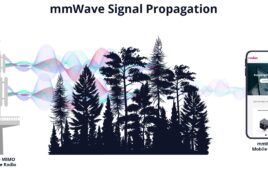IBM and Ericsson on Tuesday unveiled a new silicon-based millimeter wave phased array integrated circuit (IC) the pair said is designed for use in future 5G base stations.
According to the companies, the IC operates at 28 GHz and has already been demonstrated in a phased array antenna module, paving the way for its use in future 5G networks.
The IC is the result of two years of collaboration between the companies that combined IBM’s expertise in highly integrated phased array millimeter wave IC and antenna-in-package solutions and Ericsson’s in-depth knowledge of circuit and system design for mobile communications.
IBM indicated the module includes four monolithic integrated circuits and 64 dual-polarized antennas. It is approximately 2.8” by 2.8”, or about half the size of a typical smartphone, delivering a compact form factor the company said is necessary to support 5G’s widespread deployment, especially in indoor spaces and dense metropolitan areas. Additionally, the concurrent dual-polarization operation in both the transmit and receive modes allows one phased array antenna module to form two beams simultaneously, doubling the number of users served, the company said.
The phased array design from IBM and Ericsson also supports beam steering resolution of less than 1.4 degrees.
“The development of this 5G millimeter wave phased array is an important breakthrough, not just because of its compact size and low cost, which make it a very commercially attractive solution for network equipment companies and operators, but its potential to unleash and inspire brand new ideas and innovations we haven’t yet imagined, thanks to a fully networked society,” Dario Gil, vice president of Science and Solutions at IBM Research, said.
According to IBM the IC builds upon the company’s previous millimeter wave work, including its development of a monolithic millimeter wave radio in 2006, a highly integrated millimeter wave phased array transceiver for mobile and radar in 2013, and its explorations of how mobile handsets will communicate at millimeter wave frequencies.
The company said a paper describing IBM and Ericsson’s work on the IC – titled “A 28GHz 32-Element Phased-Array Transceiver IC with Concurrent Dual Polarized Beams and 1.4 Degree Beam-Steering Resolution for 5G Communications” – will be presented today at the 2017 International Solid State Circuits Conference in San Francisco.
Last year, Ericsson announced plans to launch what it called the world’s first commercial 5G radio for massive and multi-user MIMO sometime in 2017. Dubbed the AIR 6468, the new radio will offer a mix of advanced antennas and steerable ports to enable beamforming, Massive MIMO and multi-user MIMO. According to the company, the AIR 6468 will combine with Ericsson’s previously announced 5G Plug-Ins and current Radio System Baseband 5216 to offer operators all components of a 5G access network.
The equipment supplier push toward 5G comes as carriers across the globe prepare for the launch of next generation wireless technology.
In the United States, Verizon is moving forward with pre-commercial fixed wireless 5G pilots in 10 locations, while AT&T has teamed up with Intel on a 5G business trial and recently announced plans to test 5G technology in Austin and Indianapolis in the coming months. Unlike its competitors, Sprint has indicated it’s more focused on mobile than fixed 5G applications, and so has T-Mobile.




